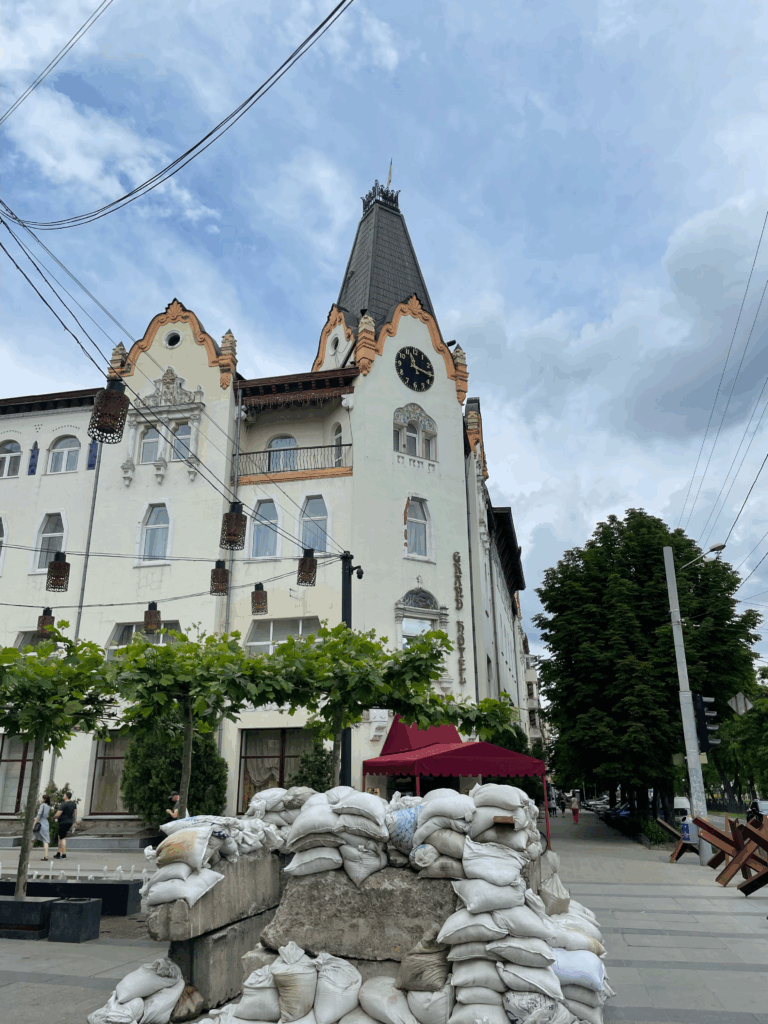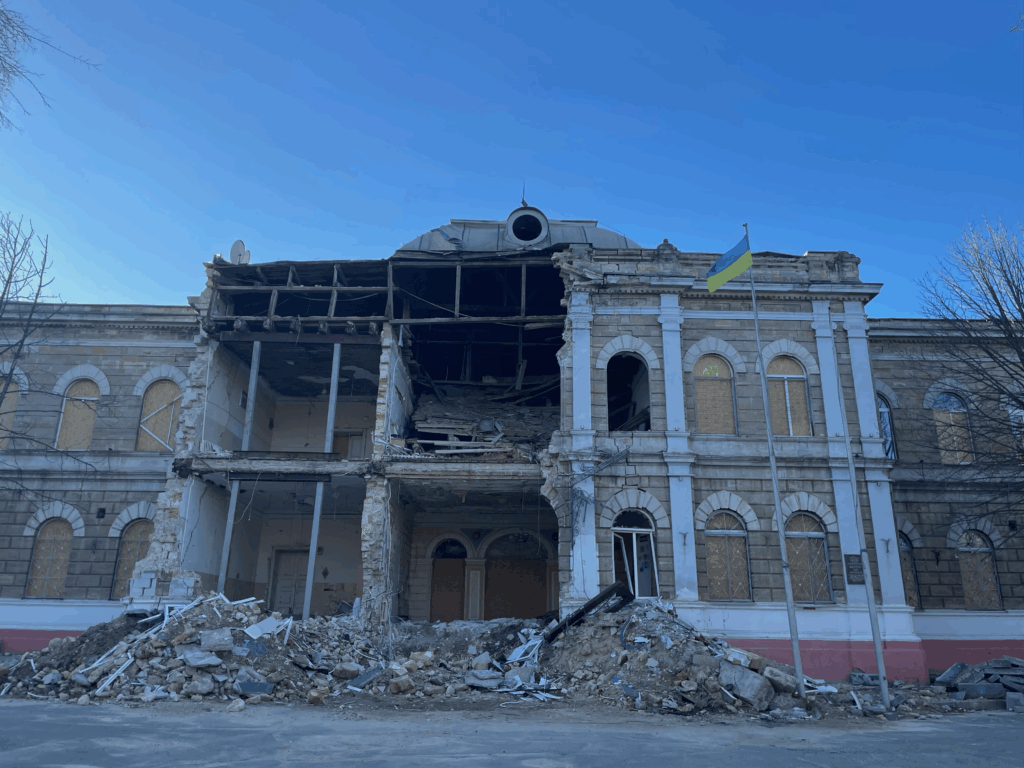“Until July 2022, it was reasonably calm here,” Anita said. Anita is a former social worker. Now she chairs a small NGO in the Zaporizhzhia region of Ukraine. This organization works with various vulnerable groups on, among other things, harm-reduction and HIV-prevention. Although the city of Enerhodar and the Zaporizhzhia Nuclear Power Plant, both of which are 15 miles away across the river, have been occupied by Russia since the early days of the invasion, it was still “relatively calm here in X,” according to Anita. (All names of my participants have been changed to protect identities and the name of the city has been anonymized.)
Unfortunately, from July onwards, the Russians have been constantly shelling the city. Meetings between social workers and clients started occurring more and more often near military checkpoints or near the “hedgehogs,” or metal anti-tank obstacles. Buildings with broken windows and no windows as well as buildings with boarded windows — to prevent glass shards — have become a normal part of the landscape.

Social workers also started wearing bulletproof vests to work to protect from glass shards should there be another shelling. The office of the organization that Anita heads was heavily damaged from shelling. The house of one of the social workers suffered as well; it is now virtually unlivable and needs to be rebuilt. Sometimes, when another air raid alert sounds, social workers meet with the clients in a bomb shelter, especially if a meeting is too important to be rescheduled or cancelled.
Social workers from the small city of X have been incredibly courageous and dedicated. Importantly, it’s not just social workers from the city of X who showed such dedication to their mission when the full-scale invasion began. Olha, who is a head of a similar organization in Kharkiv, reminisced that when the city was heavily shelled in the first days of the all-out war, she and her team would still get into the car to deliver medicine to vulnerable groups, mostly antiretrovirals for people living with HIV. Olha and her team would scan the news and the local social media chats to understand which neighborhoods and which nearby villages were at risk of being shelled. Then, they would quickly pop up at the local AIDS center, take a few batches of medicine from them, and head to some neighborhood or village, in the hopes that they would be swift enough to deliver medicine to people and that they would be lucky enough to avoid being killed in the process. There were around fifty air raid alerts a day, Olha remembered. And sometimes a shelling would start even without an alert — some of the city’s neighborhoods were too close to the enemy lines and could be easily reached by the artillery fire. Air raid alerts and shellings significantly extended social workers’ working hours. When your day is interspersed by air alerts and bombs, it is imperative that you wait out the air attack in the shelter or a cellar. Sometimes, though, you have to wait for hours at a time before it is safe to go outside and resume doing whatever you had been doing before the siren went off. Because of air attacks, a seemingly simple process of delivering medicine to a village nearby could take hours and hours.
People like Olha and Anita are the unsung heroes of the full-scale invasion. They are beyond courageous, dedicated, and caring. They were not exceptions; many other social workers all around the country reacted in the same manner by making a purposeful decision to stay and help vulnerable communities, even if this meant putting themselves at risk.
Many small Ukrainian harm-reduction and HIV-prevention organizations take peer engagement very seriously. This means that social workers who are often employed by these programs also belong to various vulnerable communities themselves. It’s not uncommon that a person working at a needle-exchange point is also a person who uses drugs who has been on medication for opioid use disorder (MOUD) for the last decade. Or that a person doing outreach work with sex workers is a (former) sex worker herself.
How did social workers in X, in Kharkiv, and many other cities muster the courage to face the threat of their own death and still decide to risk their lives in order to help their communities? Why did they proceed to care for others in the face of immediate danger and possibly their own death?
The answer, I maintain, lies in the feeling of community, especially that of a vulnerable community. In August 2021, I came to Ukraine to do my dissertation research with various vulnerable communities (mostly sex workers, people who use drugs, and people living with HIV). I was interested in the communities’ activism and increasingly important role in HIV-prevention services. To that end, I spend some time in Kyiv, Poltava, Kryvyi Rih, Mykolaiv, Kharkiv, X, and a few other places whose identity I do not want to divulge. The full-scale invasion of February 2022 caught me in the field. I stayed in Ukraine until June 2023: I accompanied social workers on their new and old routes, visited shelters for displaced people from vulnerable communities, and brought medical supplies to cities in central and eastern Ukraine that took in a lot of displaced people. But most importantly, I listened to what my interlocutors had to say: about war, about uncertainties about the future, about their anger, and, importantly, about the importance of belonging to a vulnerable community.
This feeling of belonging to a vulnerable community, I argue, has been woven through affect — shared embodied sensations and experiences, which are often experiences of suffering and vulnerability and are accompanied by a plethora of ambiguous and fluctuating feelings. I have attended many community support meetings where former and current drug users, sex workers, MOUD patients, and people living with HIV (these groups often overlap) shared their stories about past experiences of vulnerability and marginalization, trying to put into words their experiences of homelessness, gnawing hunger, and profound pain that seems it will consume your whole body. Because these experiences are so common and shared by all (or almost all) present at the community meeting, I have repeatedly witnessed how sharing a personal experience of vulnerability produces an embodied reaction in listeners: how they visibly shiver and get goosebumps when someone talks about surviving a cold winter on the streets; how people’s stomachs start growling when somebody retells a story of going hungry and not having a bite for a few days in a row and how they instinctively put their hands on their bellies to calm the sensation that reminds them of past misfortunes; how they gasp, clench their teeth, and bite their lips as if in pain when someone describes the agony of pain they endured during opioid withdrawal.
These experiences of vulnerability and suffering are not just embodied but intercorporeal and affective, meaning that they are not necessarily coded in language or transmitted verbally. Yet they are nevertheless shared and communicated, either through stories that are interspersed with silences and weeping or through embodied reactions to these stories. The commonality, the shared aspect of these experiences creates strong affective ties among my participants — and leads to community-building. This is to say that there is no universal vulnerability that all members of different vulnerable communities share. Instead, there is a set of particular shared embodied experiences of suffering and marginalization that connects my participants to each other. When stories and memories of these embodied experiences start to circulate at a community meeting, they produce an intense embodied response in people and help to affectively bind them, thus creating an affectively bounded community.

Discussing experiences of trauma among disabled veterans in Turkey, Salih Can Açiksöz notes how difficult it was for some of his participants to assimilate the trauma of losing their limbs into language. Reflecting on this difficulty, he reminds how trauma may pose “a challenge for representation, language, and cultural expression.” Importantly, he observes, that his participants still tried to talk about their loss. He argues that it is both a discourse about a shared loss and the reality of this loss that are the “therapeutic force that affectively binds” disabled veterans together.
In a similar manner, my participants often struggled to articulate their experiences of suffering and marginalization in a cohesive manner. Not all of them are conventionally good storytellers: they often stumbled, stuttered, started to weep in the middle of narration, made long pauses when searching for the right word, or didn’t finish their stories altogether. Words are not usually their best friends. My participants often struggled with words yet they persisted and continued to try. They tell their stories with words and with their bodies — stuttering, weeping, and almost putting a fist through a wall are sometimes worth a thousand words. Despite not always being good with words, they are still able to communicate their experiences of vulnerability and marginalization to others and to empathize with each other through a shared affect.
Vulnerability is embodied and, most importantly, experience-based. Looking at how my participants were struggling to articulate their experiences of vulnerability and suffering and hearing them weeping, I kept circling back to some recent theoretical attempts at relying on vulnerability as a metaphor to speculate about resistance and democratic politics in general. And the more I tried to reconcile gossamer political theories with what was in front of me, the angrier I became. Because vulnerability (however convenient it might be) is not a metaphor. It is a lived and embodied experience that has the power to create communities and to prompt people to care about others, sometimes at the expense of their own comfort and safety. It is a lived and embodied experience of profound bodily fragility, of rage because of powerlessness, of suffering and the will to survive.
Thinking about similar attempts at abstracting precariousness and vulnerability into a universal human condition, Clara Han astutely remarked that “the impulse to assembling a general theory can have a dark side.” She warns that concepts and theories that are too general may end up working against those whom the theorists intend to help in the first place. Yet, in addition to that, by abstracting vulnerability into a political metaphor, we are doing ourselves a major disservice. By stretching vulnerability into a metaphor that can be applied to the human condition as a whole, I am afraid that we’re not only disrespecting and devaluing the lives of actual people like my participants. By stretching vulnerability so much in order to theorize resistance, violence and pose questions about the human condition — questions that may or may not lead anywhere—we’re also hollowing it out, emptying it out of meaning and of its many heuristic capacities.
Dafna Rachok is an Assistant Professor of Anthropology at University of North Carolina at Chapel Hill.